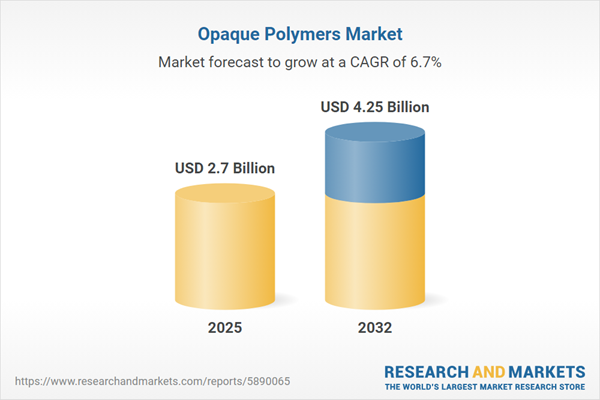Speak directly to the analyst to clarify any post sales queries you may have.
The opaque polymers market is evolving rapidly, demanding new strategies from senior leadership as organizations adapt to advanced sustainability standards, regulatory changes, and procurement innovation. Navigating this transformation successfully requires a proactive approach and clear focus on compliance, technology, and operational resilience.
Market Snapshot: Opaque Polymers Market Dynamics
The opaque polymers market is witnessing robust compound annual growth, fueled by expanding applications in core sectors such as automotive, construction, coatings, and electronics. Increased demand is driving organizations to prioritize the delivery of high-performance polymer solutions that address stringent quality and regulatory requirements across various industries. Additionally, sustainability objectives are reshaping market expectations, prompting continuous adaptations in procurement and manufacturing strategies. Variability in regulatory frameworks worldwide urges producers to refine process innovation and anticipate shifting end-user demands, strengthening future market positioning.
Scope & Segmentation: Opaque Polymers Market Overview
- Polymer Chemistries: Acrylic, alkyd, epoxy, and polyester polymers are selected for proven durability, extended lifecycle, and their alignment with compliance standards in industrial and commercial applications.
- Technology Types: Powder-based, solvent-based, and water-based systems are tailored to support environmental sustainability and production efficiency in industrial environments.
- Application Verticals: Automotive, construction, coatings, and electronics leverage opaque polymers for specialized durability, technical performance, and adherence to regulatory benchmarks.
- Regional Markets: Market analysis includes the Americas, Europe, Middle East, Africa, and Asia-Pacific, evaluating regional procurement, regulatory demands, and the strategic importance of localized adaptation for competitive presence.
- Key Players Profiled: Major contributors such as BASF SE, The Dow Chemical Company, LyondellBasell Industries N.V., Saudi Basic Industries Corporation, DuPont de Nemours, Inc., Covestro AG, Eastman Chemical Company, Celanese Corporation, Evonik Industries AG, and Avient Corporation have been recognized for innovation, dependability, and supply chain optimization.
- Geographic Focus: The report provides depth in North America, Latin America, Europe, Middle East, Africa, and Asia-Pacific, including regulatory trend analysis for the United States, Canada, Germany, China, India, Japan, and South Korea to inform localized decision-making strategies.
Key Takeaways for Senior Decision-Makers
- Adoption of recyclable and renewable feedstocks in procurement supports sustainability commitments and enables readiness for stricter environmental requirements throughout the supply chain.
- Advanced process analytics and predictive maintenance enhance operational efficiency, increase production uptime, and provide flexibility in addressing shifting market dynamics.
- Implementation of modern production technologies with responsible material sourcing enhances regulatory compliance and builds resilience, offering particular advantages in regions with elevated industry standards.
- Targeted sourcing strategies, innovation partnerships, and customer engagement tailored to regional variations boost organizational responsiveness and growth potential across markets.
- Diversification in both product and technology offerings enhances agility, enabling organizations to better manage cost shifts and regulatory uncertainty in the market landscape.
Tariff Impact: 2025 United States Trade Adjustments
New tariff regulations in the United States are set to reshape the competitive landscape for imported opaque polymer goods. Domestic producers are reviewing pricing models and supplier arrangements to mitigate cost uncertainties, while international companies are reevaluating their logistics and compliance processes. Continual regulatory monitoring is necessary to safeguard profit margins and maintain a stable supply throughout the period of transition.
Methodology & Data Sources
This market report draws on primary research from executive and procurement leader interviews complemented by data from leading industry publications, intellectual property repositories, international trading statistics, and formal regulatory updates. This multi-source approach delivers a robust foundation for strategic decision-making for senior leaders.
Why This Opaque Polymers Market Report Matters
- Equips executive teams with the clarity required to direct investments and innovation activities in line with regulatory developments and future market trends.
- Highlights vital technology shifts and evolving compliance landscapes, supporting the construction of adaptable and resilient supply chains for proactive risk management.
- Offers actionable segmentation along with a clear view of the evolving competitive context, empowering senior leadership to pursue effective, region-specific strategies in global industries.
Conclusion
For organizations competing in the opaque polymers market, success depends on continuous innovation, agile strategy, and forward-thinking leadership. Prioritizing adaptation and compliance positions companies for robust operational performance and long-term value creation.
Additional Product Information:
- Purchase of this report includes 1 year online access with quarterly updates.
- This report can be updated on request. Please contact our Customer Experience team using the Ask a Question widget on our website.
Table of Contents
3. Executive Summary
4. Market Overview
7. Cumulative Impact of Artificial Intelligence 2025
Companies Mentioned
The companies profiled in this Opaque Polymers market report include:- BASF SE
- The Dow Chemical Company
- LyondellBasell Industries N.V.
- Saudi Basic Industries Corporation
- DuPont de Nemours, Inc.
- Covestro AG
- Eastman Chemical Company
- Celanese Corporation
- Evonik Industries AG
- Avient Corporation
Table Information
| Report Attribute | Details |
|---|---|
| No. of Pages | 188 |
| Published | November 2025 |
| Forecast Period | 2025 - 2032 |
| Estimated Market Value ( USD | $ 2.7 Billion |
| Forecasted Market Value ( USD | $ 4.25 Billion |
| Compound Annual Growth Rate | 6.7% |
| Regions Covered | Global |
| No. of Companies Mentioned | 11 |









